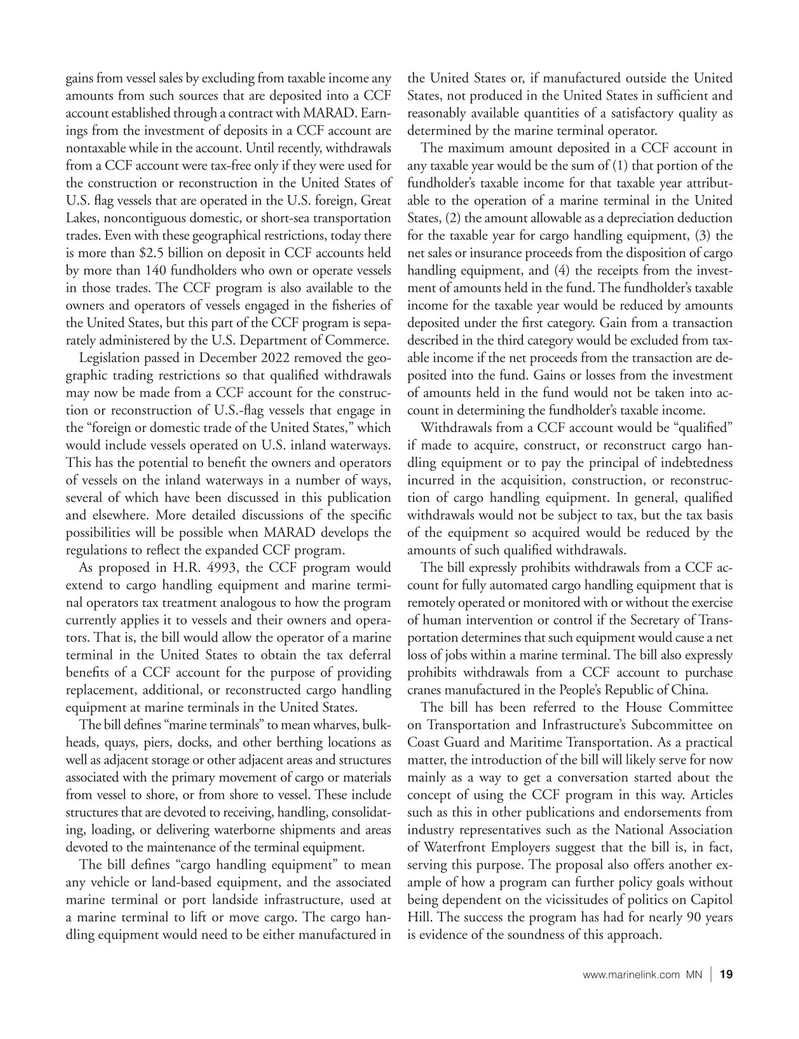
Page 19: of Marine News Magazine (November 2023)
Workboat Edition
Read this page in Pdf, Flash or Html5 edition of November 2023 Marine News Magazine
gains from vessel sales by excluding from taxable income any the United States or, if manufactured outside the United amounts from such sources that are deposited into a CCF States, not produced in the United States in suf? cient and account established through a contract with MARAD. Earn- reasonably available quantities of a satisfactory quality as ings from the investment of deposits in a CCF account are determined by the marine terminal operator.
nontaxable while in the account. Until recently, withdrawals The maximum amount deposited in a CCF account in from a CCF account were tax-free only if they were used for any taxable year would be the sum of (1) that portion of the the construction or reconstruction in the United States of fundholder’s taxable income for that taxable year attribut-
U.S. ? ag vessels that are operated in the U.S. foreign, Great able to the operation of a marine terminal in the United
Lakes, noncontiguous domestic, or short-sea transportation States, (2) the amount allowable as a depreciation deduction trades. Even with these geographical restrictions, today there for the taxable year for cargo handling equipment, (3) the is more than $2.5 billion on deposit in CCF accounts held net sales or insurance proceeds from the disposition of cargo by more than 140 fundholders who own or operate vessels handling equipment, and (4) the receipts from the invest- in those trades. The CCF program is also available to the ment of amounts held in the fund. The fundholder’s taxable owners and operators of vessels engaged in the ? sheries of income for the taxable year would be reduced by amounts the United States, but this part of the CCF program is sepa- deposited under the ? rst category. Gain from a transaction rately administered by the U.S. Department of Commerce. described in the third category would be excluded from tax-
Legislation passed in December 2022 removed the geo- able income if the net proceeds from the transaction are de- graphic trading restrictions so that quali? ed withdrawals posited into the fund. Gains or losses from the investment may now be made from a CCF account for the construc- of amounts held in the fund would not be taken into ac- tion or reconstruction of U.S.-? ag vessels that engage in count in determining the fundholder’s taxable income.
the “foreign or domestic trade of the United States,” which Withdrawals from a CCF account would be “quali? ed” would include vessels operated on U.S. inland waterways. if made to acquire, construct, or reconstruct cargo han-
This has the potential to bene? t the owners and operators dling equipment or to pay the principal of indebtedness of vessels on the inland waterways in a number of ways, incurred in the acquisition, construction, or reconstruc- several of which have been discussed in this publication tion of cargo handling equipment. In general, quali? ed and elsewhere. More detailed discussions of the speci? c withdrawals would not be subject to tax, but the tax basis possibilities will be possible when MARAD develops the of the equipment so acquired would be reduced by the regulations to re? ect the expanded CCF program. amounts of such quali? ed withdrawals.
As proposed in H.R. 4993, the CCF program would The bill expressly prohibits withdrawals from a CCF ac- extend to cargo handling equipment and marine termi- count for fully automated cargo handling equipment that is nal operators tax treatment analogous to how the program remotely operated or monitored with or without the exercise currently applies it to vessels and their owners and opera- of human intervention or control if the Secretary of Trans- tors. That is, the bill would allow the operator of a marine portation determines that such equipment would cause a net terminal in the United States to obtain the tax deferral loss of jobs within a marine terminal. The bill also expressly bene? ts of a CCF account for the purpose of providing prohibits withdrawals from a CCF account to purchase replacement, additional, or reconstructed cargo handling cranes manufactured in the People’s Republic of China.
equipment at marine terminals in the United States. The bill has been referred to the House Committee
The bill de? nes “marine terminals” to mean wharves, bulk- on Transportation and Infrastructure’s Subcommittee on heads, quays, piers, docks, and other berthing locations as Coast Guard and Maritime Transportation. As a practical well as adjacent storage or other adjacent areas and structures matter, the introduction of the bill will likely serve for now associated with the primary movement of cargo or materials mainly as a way to get a conversation started about the from vessel to shore, or from shore to vessel. These include concept of using the CCF program in this way. Articles structures that are devoted to receiving, handling, consolidat- such as this in other publications and endorsements from ing, loading, or delivering waterborne shipments and areas industry representatives such as the National Association devoted to the maintenance of the terminal equipment. of Waterfront Employers suggest that the bill is, in fact,
The bill de? nes “cargo handling equipment” to mean serving this purpose. The proposal also offers another ex- any vehicle or land-based equipment, and the associated ample of how a program can further policy goals without marine terminal or port landside infrastructure, used at being dependent on the vicissitudes of politics on Capitol a marine terminal to lift or move cargo. The cargo han- Hill. The success the program has had for nearly 90 years dling equipment would need to be either manufactured in is evidence of the soundness of this approach.
www.marinelink.com MN 19|

 18
18

 20
20
